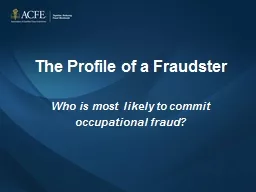

Who is most likely to commit occupational fraud International Fraud Awareness Week This presentation was created by the Association of Certified Fraud Examiners ACFE for International Fraud Awareness Week ID: 686938
Download Presentation The PPT/PDF document "The Profile of a Fraudster" is the property of its rightful owner. Permission is granted to download and print the materials on this web site for personal, non-commercial use only, and to display it on your personal computer provided you do not modify the materials and that you retain all copyright notices contained in the materials. By downloading content from our website, you accept the terms of this agreement.
Slide1
The Profile of a Fraudster
Who is most likely to commit
occupational fraud?Slide2
International Fraud Awareness Week
This presentation was created by the
Association of Certified Fraud Examiners (ACFE)
for
International Fraud Awareness Week.
Visit
www.FraudWeek.com
for more information.Slide3
The Cost of Occupational Fraud
According to the ACFE’s
2012 Report to the Nations on Occupational Fraud & Abuse
, organizations lose an estimated five percent of their annual revenues to fraud.
Applied to the estimated 2011 Gross World Product, this figure translates to a potential global fraud loss of more than $3.5 trillion.
The median loss caused by the occupational fraud cases in our study was $140,000.
More than one-fifth of the frauds involved losses of at least $1 million.
The frauds lasted a median of 18 months before being detected.
Slide4
The Profile of a Fraudster
A fraud suspect might not be easy to pick out of a crowd - or from a rap sheet. However, ACFE research helps identify certain common traits and red flags.Slide5
Profile of a Fraudster
The Age Factor
More than half of all cases in the study were committed by individuals between the ages of 31 and 45.
Generally speaking, median losses tended to rise with the age of the perpetrator. This trend is also reflected in tenure at an organization.Slide6
Profile of a Fraudster
The Perpetrator’s Department
Fraud offenders were most likely to be found in one of six departments:
Accounting (22%)
Operations (17%)
Sales (13%)
Executive/upper management (12%)
Customer service (7%)
Purchasing (6%)Slide7
Profile of a Fraudster
A Clean Record
Most of the fraudsters in the study had never been previously charged or convicted for a fraud-related offense.
Only
six
percent of the perpetrators had been previously convicted of a fraud offense. This finding is consistent with prior ACFE studies.Slide8
Profile of a Fraudster
Warning Signs and Red Flags
The most common behavioral red flags displayed by perpetrators:
Living beyond one’s means (36 percent of cases)
Experiencing financial difficulties (27 percent of cases)Slide9
Profile of a Fraudster
More Behavioral Red Flags
Unusually close association with vendor/customer
(19%)
Control issues; unwillingness to share duties (18%)
“Wheeler-dealer” attitude (15%)
Divorce/family problems (15%)
Irritability, suspiciousness or defensiveness (13%)
Addiction problems (8%)
Refusal to take vacations (7%)Slide10
Profile of a Fraudster
Tone at the Top
High-level perpetrators cause the greatest damage to their organizations.
Frauds committed by owners/executives were more than three times as costly as frauds committed by managers, and more than nine times as costly as employee frauds.
Executive-level frauds also took much longer to detect.Slide11
Profile of a Fraudster
The most common crimes committed in the executive suite:
Corruption (54%)
Billing schemes (33%)
Expense reimbursement fraud (21%)
Fraudulent statements (21%)
Non-cash (16%)
Other schemes include skimming, cash on hand, payroll fraud, cash larceny, check tampering and register disbursementsSlide12
Additional Resources
The ACFE’s
2012 Report to the Nations on Occupational Fraud & Abuse
is drawn from a survey of 1,388 Certified Fraud Examiners (CFEs) who investigated fraud cases between January 2010 and December 2011.
In addition to studying the traits of perpetrators, the
Report
includes data on how occupational fraud is committed and detected, as well as the characteristics of the victim organization.
The
Report to the Nations
is available for download online at the ACFE’s web site:
www.ACFE.com/RTTN
. The
Report
is in PDF format.Slide13
Additional Resources
Find more information about preventing and detecting fraud at the following web sites:
The Association of Certified Fraud Examiners (
www.ACFE.com
)
The Federal Bureau of Investigation (
www.FBI.gov
)
The National White Collar Crime Center (
www.nwc3.org
)
U.S. Government Accountability Office (
www.GAO.gov
)
Internal Revenue Service (
www.IRS.gov
) Slide14
About the ACFE
The ACFE is the world's largest anti-fraud organization and premier provider of anti-fraud training and education. Together with nearly 65,000 members, the ACFE is reducing business fraud world-wide and inspiring public confidence in the integrity and objectivity within the profession
. Visit ACFE.com for more information.